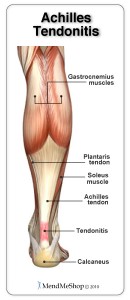 Achilles tendinitis is inflammation of the tendon due to injury, strain or overuse. It can occur at the insertion point of the tendon (referred to as insertional tendinitis) at the calcaneus (heel bone) or mid way up the Achilles tendon (referred to as non-insertional tendinitis). The most common area to be affected by tendinitis is approximately 1/3 of the way up the tendon, 2.5 inches from where it attaches to the heel bone. This part of the Achilles tendon is at most risk of tendinitis and other tendon injuries because it receives less blood flow than other parts of the tendon.
Achilles tendinitis is inflammation of the tendon due to injury, strain or overuse. It can occur at the insertion point of the tendon (referred to as insertional tendinitis) at the calcaneus (heel bone) or mid way up the Achilles tendon (referred to as non-insertional tendinitis). The most common area to be affected by tendinitis is approximately 1/3 of the way up the tendon, 2.5 inches from where it attaches to the heel bone. This part of the Achilles tendon is at most risk of tendinitis and other tendon injuries because it receives less blood flow than other parts of the tendon.
Symptoms
If you are suffering from Achilles tendinitis you will most likely be experiencing:
- Sharp pain at the beginning of activity that decreases in intensity as exercise progresses.
- Pain that returns after exercise or after long periods of inactivity.
- Pain may subside when the Achilles tendon is allowed to rest.
- Pain becomes most significant when pushing off or jumping.
- Stiffness in your Achilles tendon when you wake up in the morning.
- Tender and warm to the touch.
- The Achilles tendon is irritated by heat but feels good when treated with cold compression and rest.
If you feel a sharp pain, as though you’ve been hit in the back of the ankle, and hear a “pop” sound, your Achilles tendon has likely ruptured. A ruptured (completely torn) Achilles tendon can occur when the Achilles tendon is overstressed to the point of tearing. It will be very difficult for you to walk or move your ankle if this is the case.
Causes
Achilles tendonitis may be caused by:
- Improper stretching before and after running and jumping exercises.
- Changes in foot wear (i.e. high heels, poor running shoes).
- An inflexible Achilles tendon (i.e. tendon with scar tissue from previous injury or wear and tear).
- An increase in training, training on uneven terrain or a change in terrain (i.e. hills) .
- Weak or inflexible calf muscles (gastrocnemius or soleus muscles).
Achilles Tendon Treatments
It is important to treat Achilles tendon injuries as soon as possible, as any activity or strain you put on your tendon can re-injure it further. Though the pain, discomfort, and inconvenience of an Achilles condition can be overwhelming, it is possible to overcome it.
The trick with any tendon injury is getting it toheal with minimal scar tissue formation. Even with optimum healing, there is always less elasticity in a previously injured tendon. This will cause the tendon to hurt, during exercise and everyday activities. However, if you heal your injury efficiently and quickly, your chance of re-injury later on is much lower than average.
Allowing your Achilles tendon to rest is always recommended following injury. Avoid all activities that may have caused the injury or irritation andbegin cold compression treatments as soon as possible. The Achilles tendon is a difficult tendon to rest completely as it is an essential tendon for walking and daily activities. Fortunately, there are healing tools that can help treat your tendon and speed up the healing process so you can get back to a life without pain and risk of further injury. Blood Flow Stimulation Therapy™ (BFST®) will promote blood flow to heal your tendon faster and more completely than any other methods available.
Although steroid injections may provide temporary relief from the pain of Achilles tendinitis, they should generally be avoided as they weaken the tendon and may lead to a rupture. If you do opt for an injection, doctors usually recommend that you do not participate in strenuous activities for several weeks to reduce the risk of a rupture.